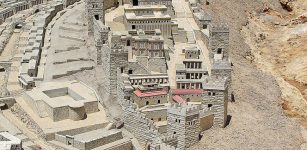Vesta And Her Six Vestal Virgins – Highly Venerated Goddess Of Hearth And Family
A. Sutherland - AncientPages.com - In ancient Roman beliefs, Vesta (the equivalent of the Greeks' Hestia) was the goddess of fire, home, and family.
She was an abstract goddess of the hearth, chastity, and ritual bonfires.
The goddess was rarely depicted in human form, and generally, no myths are associated with her. However, Vesta is one of the most important Roman divinities and probably one of the oldest European deities. She was one of the daughters of Saturn and Ops, a goddess of fertility and earth.
No temple or household began with their ceremonies until Vesta's fire was lit. The cult of Vesta, however, was religious worship that lay deep in our Indo-European past and was grown privately by individual families.
Also, the veneration of fire is an old tradition. Fire has been essential in human life since the dawn of history. The deification of fire is known from various Indo-European cultures. One of the most important deities in the Slavic pantheon was Svarog (Swarog), the god of celestial fire and the guardian of the Slavic home fire and the sacrificial fire. In Vedic India, people worshiped the fire-god Agni (which means: 'fire'), and the ancient Iranian Zoroastrians were famous fire-worshippers. Their concept of holy fire was Atar (fire god).
Officially, Vesta was represented by the sacred, eternal fire in her temple in the Roman Forum ('Forum Romanum'), considered the heart of ancient Rome.
Despite that worship of Vesta, and several other gods, had its roots in the Roman home, with time, it developed into an established cult during the reign of either Romulus or Numa Pompilius.
The latter is believed to have introduced her worship in Rome and constructed the temple in Vesta's honor, initially located on the slope of Palatine Hill. It was not an ordinary temple where gatherings could occur, as in other Roman temples.
 A vestal virgin. Gravy av Frederick Leighton, circa 1890. Public Domain
A vestal virgin. Gravy av Frederick Leighton, circa 1890. Public Domain
An eternal fire, representing Vesta, burned in the temple, and it ceased to exist in 394 AD at the order of the Christian Emperor Theodosius the Great, a Roman Emperor from 379 to 395. Theodosius (who also banned the pagan rituals of the Olympics in ancient Greece) dissolved the Order of the Vestal Virgins in Rome.
Vestals And Their Life After Thirty-Year-Long Service
Her priestesses - Vestals - were the virgins who kept and cared for the sacred fire that symbolized the existence of Rome (the 'eternal city').
According to tradition, six chosen vestals came to serve the goddess. These girls (seven to 10 years old and from good families) had to take a vow of chastity. If the vow was broken and the Vestal was found guilty, she was punished by being walled up in the Campus Sceleris ('Field of Wickedness') and left for her death.
The priestesses were freed of the usual social obligations to marry and bear children. Instead, they devoted themselves to the study and correcting state rituals that were off-limits to the male colleges of priests.
 Vestal virgin hanging an ivy wreath during Vestalia Festival. Carl Friedrich Deckler (1838–1918). Public Domain
Vestal virgin hanging an ivy wreath during Vestalia Festival. Carl Friedrich Deckler (1838–1918). Public Domain
The Vestals played an essential role in ancient Rome's ceremonial life. Besides guarding Vesta's fire, the Vestals often attended festivals, and their duties included making the so-called "salted flour" (mola salsa), a mixture sprinkled over the sacrificial animals. The Vestals served in the temple for thirty years before being replaced by new ones.
After thirty years, the Vestal could give up the priesthood, return to ordinary life and even get married. Few of them, however, used this right. Instead, they preferred to serve the goddess until their death.
Vestals could, with their own hands, without a guarantor, manage their affairs, which for the most part, were not allowed to other Roman women.
The Vestals in the service enjoyed great privileges and honors as a reward for their long and dedicated service. The consul himself at the meeting gave way to the vestals.
 Statues of the Vestal Virgins - in front of the Atrium Vestae. Image Credit: Carole Raddato - CC BY-SA 2.0
Statues of the Vestal Virgins - in front of the Atrium Vestae. Image Credit: Carole Raddato - CC BY-SA 2.0
Vestalia Festival That Honored The Goddess And Her Priestesses
Vesta was highly respected as the one who watched over the hearth, which provided light and warmth, nourishment, and protection to the family. In this way, she was a guardian of the Roman people, and as much as they divinized the hearth, they also honored Vesta's existence by organizing the Vestalia. It was one of the most celebrated Roman holidays from the 7th to the 15th of June each year.
During this holiday, married women made offerings in the form of food in Vesta's temple. It was also a festival of bakers; Vesta's priestesses baked special bread made of salted flour, and the mills were decorated with wreaths and flowers.
Written by – A. Sutherland - AncientPages.com Senior Staff Writer
Updated on March 30, 2024
Copyright © AncientPages.com All rights reserved. This material may not be published, broadcast, rewritten or redistributed in whole or part without the express written permission of AncientPages.com
Expand for referencesReferences:
Benjamin W. Fortson, IV, Indo-European Language, and Culture: An Introduction
Mary Beard M. North J. Religions of Rome: Volume 1
More From Ancient Pages
-
 How Did A Piece Of An ‘Epic’ Viking Sword End Up In The Netherlands?
Vikings | Dec 4, 2024
How Did A Piece Of An ‘Epic’ Viking Sword End Up In The Netherlands?
Vikings | Dec 4, 2024 -
 Etruscan Beautiful Bronze Lamp of Cortona – Studied
Artifacts | Apr 10, 2024
Etruscan Beautiful Bronze Lamp of Cortona – Studied
Artifacts | Apr 10, 2024 -
 Herne The Hunter – The Horned God And Lord Of The Forest In British Mythology
Featured Stories | Jan 12, 2016
Herne The Hunter – The Horned God And Lord Of The Forest In British Mythology
Featured Stories | Jan 12, 2016 -
 Merkhet – An Ancient Egyptian Timekeeping Instrument
Ancient History Facts | Jul 3, 2018
Merkhet – An Ancient Egyptian Timekeeping Instrument
Ancient History Facts | Jul 3, 2018 -
 Cerberus – Giant Multi-Headed Dog Guards The Underworld Of God Hades In Greek Mythology
Featured Stories | Jun 2, 2020
Cerberus – Giant Multi-Headed Dog Guards The Underworld Of God Hades In Greek Mythology
Featured Stories | Jun 2, 2020 -
 Treasure Hunters Encounter Something Unexplained In The Arizona Mountains
Featured Stories | Apr 7, 2022
Treasure Hunters Encounter Something Unexplained In The Arizona Mountains
Featured Stories | Apr 7, 2022 -
 Mysterious Voynich Manuscript Was Written In Two Languages – Scientists Say
Archaeology | Apr 24, 2017
Mysterious Voynich Manuscript Was Written In Two Languages – Scientists Say
Archaeology | Apr 24, 2017 -
 35,000 Unique Artifacts Discovered In 720-Year-Old Iroquoian Village In Canada
Archaeology | Oct 24, 2020
35,000 Unique Artifacts Discovered In 720-Year-Old Iroquoian Village In Canada
Archaeology | Oct 24, 2020 -
 Tiglath Pileser III: Neo-Assyria’s Strong King Who Built A Mighty Empire
Featured Stories | May 2, 2019
Tiglath Pileser III: Neo-Assyria’s Strong King Who Built A Mighty Empire
Featured Stories | May 2, 2019 -
 Syamantaka – Divine Jewel With Magical Powers Was A Gift From The Sun God In Hindu Mythology
Featured Stories | Mar 1, 2019
Syamantaka – Divine Jewel With Magical Powers Was A Gift From The Sun God In Hindu Mythology
Featured Stories | Mar 1, 2019 -
 Pharaoh Psamtik III’s Deadly Encounter With Cambyses II Of Persia Ended The 26th Dynasty Of Egypt
Featured Stories | Apr 16, 2021
Pharaoh Psamtik III’s Deadly Encounter With Cambyses II Of Persia Ended The 26th Dynasty Of Egypt
Featured Stories | Apr 16, 2021 -
 Cursed Magical Dainsleif Sword Of King Hogni And Legendary Battle That Continues Until The Coming Of Ragnarok
Featured Stories | Jul 21, 2018
Cursed Magical Dainsleif Sword Of King Hogni And Legendary Battle That Continues Until The Coming Of Ragnarok
Featured Stories | Jul 21, 2018 -
 Why Is La Ferrassie Man A Unique And Famous Neanderthal?
Featured Stories | Oct 30, 2023
Why Is La Ferrassie Man A Unique And Famous Neanderthal?
Featured Stories | Oct 30, 2023 -
 X-Ray Reveal Ghostly Portrait Of Mary Queen Of Scots Hidden Underneath 16th Century Painting
Archaeology | Nov 3, 2017
X-Ray Reveal Ghostly Portrait Of Mary Queen Of Scots Hidden Underneath 16th Century Painting
Archaeology | Nov 3, 2017 -
 How Did These Beautiful Venetian Glass Beads Reach North America Long Before Columbus?
Archaeology | Feb 15, 2021
How Did These Beautiful Venetian Glass Beads Reach North America Long Before Columbus?
Archaeology | Feb 15, 2021 -
 Has a 2,000 Year Old Podium Been Found in the City of David?
Civilizations | Sep 2, 2015
Has a 2,000 Year Old Podium Been Found in the City of David?
Civilizations | Sep 2, 2015 -
 Image Of The Day: ‘The Standard of Ur – War And Peace’
Civilizations | Sep 7, 2015
Image Of The Day: ‘The Standard of Ur – War And Peace’
Civilizations | Sep 7, 2015 -
 Adad ‘Lord Of Abundance’- Mesopotamian Weather God Who Was Responsible For Fertility, Wealth And Oracles
Featured Stories | Mar 11, 2020
Adad ‘Lord Of Abundance’- Mesopotamian Weather God Who Was Responsible For Fertility, Wealth And Oracles
Featured Stories | Mar 11, 2020 -
 Evolution Mystery – Mini-Proteins In Human Organs Appeared ‘From Nowhere’
Human Beginnings | Feb 20, 2023
Evolution Mystery – Mini-Proteins In Human Organs Appeared ‘From Nowhere’
Human Beginnings | Feb 20, 2023 -
 A 1,600-Year-Old Mosaic Accidentally Unearthed In Ancient City Of Yavne, Israel
Archaeology | Apr 26, 2021
A 1,600-Year-Old Mosaic Accidentally Unearthed In Ancient City Of Yavne, Israel
Archaeology | Apr 26, 2021

